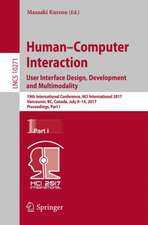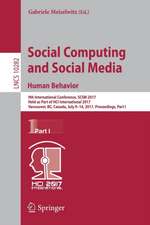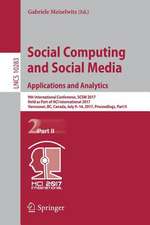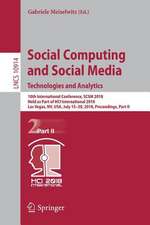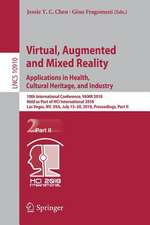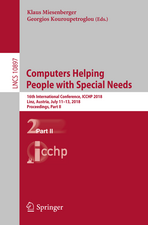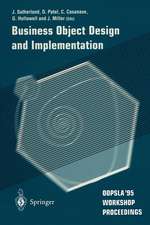Experience with Technology: Dynamics of User Experience with Mobile Media Devices: SpringerBriefs in Computer Science
Autor Ali al-Azzawien Limba Engleză Paperback – 24 sep 2013
Experience with Technology uses personal construct theory (PCT) as a theoretical and methodological starting point to this project. Major case-studies are described that examine people’s experiences with mobile media devices. The results show a group of super-ordinate constructs that, upon interaction, undergo a change in the way they vary and relate to each other, as well as the development of a high reliability UX-Scale.
The book concludes by proposing the ICE (Interaction, Construction, and Evaluation) model of UX that consolidates its findings into a workable framework of UX. The proposed framework will be of particular use to designers and practitioners, and forms an empirically grounded starting point for further research.
Din seria SpringerBriefs in Computer Science
-
 Preț: 475.83 lei
Preț: 475.83 lei - 20%
 Preț: 166.97 lei
Preț: 166.97 lei - 20%
 Preț: 349.15 lei
Preț: 349.15 lei - 20%
 Preț: 302.49 lei
Preț: 302.49 lei -
 Preț: 381.81 lei
Preț: 381.81 lei -
 Preț: 446.47 lei
Preț: 446.47 lei - 20%
 Preț: 296.17 lei
Preț: 296.17 lei - 20%
 Preț: 335.66 lei
Preț: 335.66 lei - 20%
 Preț: 463.83 lei
Preț: 463.83 lei - 20%
 Preț: 323.00 lei
Preț: 323.00 lei - 20%
 Preț: 322.35 lei
Preț: 322.35 lei - 20%
 Preț: 321.85 lei
Preț: 321.85 lei - 20%
 Preț: 232.68 lei
Preț: 232.68 lei -
 Preț: 375.45 lei
Preț: 375.45 lei - 20%
 Preț: 323.00 lei
Preț: 323.00 lei - 20%
 Preț: 322.81 lei
Preț: 322.81 lei - 20%
 Preț: 324.17 lei
Preț: 324.17 lei - 20%
 Preț: 323.00 lei
Preț: 323.00 lei - 20%
 Preț: 322.17 lei
Preț: 322.17 lei - 20%
 Preț: 322.50 lei
Preț: 322.50 lei - 20%
 Preț: 323.34 lei
Preț: 323.34 lei - 20%
 Preț: 324.17 lei
Preț: 324.17 lei - 20%
 Preț: 323.46 lei
Preț: 323.46 lei - 20%
 Preț: 322.17 lei
Preț: 322.17 lei - 20%
 Preț: 322.02 lei
Preț: 322.02 lei -
 Preț: 341.50 lei
Preț: 341.50 lei - 20%
 Preț: 324.49 lei
Preț: 324.49 lei -
 Preț: 344.47 lei
Preț: 344.47 lei -
 Preț: 376.80 lei
Preț: 376.80 lei -
 Preț: 377.18 lei
Preț: 377.18 lei - 20%
 Preț: 324.17 lei
Preț: 324.17 lei - 20%
 Preț: 352.26 lei
Preț: 352.26 lei - 20%
 Preț: 321.32 lei
Preț: 321.32 lei - 20%
 Preț: 322.17 lei
Preț: 322.17 lei - 20%
 Preț: 324.17 lei
Preț: 324.17 lei - 20%
 Preț: 322.02 lei
Preț: 322.02 lei -
 Preț: 374.46 lei
Preț: 374.46 lei - 20%
 Preț: 320.21 lei
Preț: 320.21 lei - 20%
 Preț: 323.34 lei
Preț: 323.34 lei - 20%
 Preț: 324.17 lei
Preț: 324.17 lei - 20%
 Preț: 231.84 lei
Preț: 231.84 lei - 20%
 Preț: 294.97 lei
Preț: 294.97 lei - 20%
 Preț: 322.50 lei
Preț: 322.50 lei - 20%
 Preț: 323.46 lei
Preț: 323.46 lei -
 Preț: 374.08 lei
Preț: 374.08 lei -
 Preț: 408.23 lei
Preț: 408.23 lei - 20%
 Preț: 321.52 lei
Preț: 321.52 lei - 20%
 Preț: 323.34 lei
Preț: 323.34 lei - 20%
 Preț: 323.00 lei
Preț: 323.00 lei
Preț: 325.63 lei
Preț vechi: 407.03 lei
-20% Nou
Puncte Express: 488
Preț estimativ în valută:
62.32€ • 64.82$ • 51.45£
62.32€ • 64.82$ • 51.45£
Carte disponibilă
Livrare economică 24 martie-07 aprilie
Preluare comenzi: 021 569.72.76
Specificații
ISBN-13: 9781447153962
ISBN-10: 1447153960
Pagini: 113
Ilustrații: XV, 142 p. 55 illus.
Dimensiuni: 155 x 235 x 15 mm
Greutate: 0.23 kg
Ediția:2014
Editura: SPRINGER LONDON
Colecția Springer
Seria SpringerBriefs in Computer Science
Locul publicării:London, United Kingdom
ISBN-10: 1447153960
Pagini: 113
Ilustrații: XV, 142 p. 55 illus.
Dimensiuni: 155 x 235 x 15 mm
Greutate: 0.23 kg
Ediția:2014
Editura: SPRINGER LONDON
Colecția Springer
Seria SpringerBriefs in Computer Science
Locul publicării:London, United Kingdom
Public țintă
ResearchCuprins
Foreword by David Frohlich and Margaret Wilson.- Preface.- Introduction.- Theories of Experience.- Measuring Experience.- Construct Dynamics: Interaction.- Construct Dynamics: Consumption.- ICE: A Model of Experience with Technology.- Conclusions.- Appendices.
Recenzii
From the reviews:
“The book’s main results address three important topics. The first is the conceptualization of the technology, or the way people interpret it. The author then investigates the dynamics of user experience, followed by his proposal of an original model for user experience. … this book addresses a topic of high interest in an age of tremendous technological development: user experience. … this book may be more useful to design/marketing people … .” (D. Grigoras, Computing Reviews, May, 2014)
“The book’s main results address three important topics. The first is the conceptualization of the technology, or the way people interpret it. The author then investigates the dynamics of user experience, followed by his proposal of an original model for user experience. … this book addresses a topic of high interest in an age of tremendous technological development: user experience. … this book may be more useful to design/marketing people … .” (D. Grigoras, Computing Reviews, May, 2014)
Textul de pe ultima copertă
With a focus on gaining an empirically derived understanding of the underlying psychological dimensions and processes behind people’s experiences with technology, this book contributes to the debate of user experience (UX) within several disciplines, including HCI, design and marketing. It analyses UX dynamics at various time scales, and explores the very nature of time and meaning in the context of UX.
Experience with Technology uses personal construct theory (PCT) as a theoretical and methodological starting point to this project. Major case-studies are described that examine people’s experiences with mobile media devices. The results show a group of super-ordinate constructs that, upon interaction, undergo a change in the way they vary and relate to each other, as well as the development of a high reliability UX-Scale.
The book concludes by proposing the ICE (Interaction, Construction, and Evaluation) model of UX that consolidates its findings into a workable framework of UX. The proposed framework will be of particular use to designers and practitioners, and forms an empirically grounded starting point for further research.
Experience with Technology uses personal construct theory (PCT) as a theoretical and methodological starting point to this project. Major case-studies are described that examine people’s experiences with mobile media devices. The results show a group of super-ordinate constructs that, upon interaction, undergo a change in the way they vary and relate to each other, as well as the development of a high reliability UX-Scale.
The book concludes by proposing the ICE (Interaction, Construction, and Evaluation) model of UX that consolidates its findings into a workable framework of UX. The proposed framework will be of particular use to designers and practitioners, and forms an empirically grounded starting point for further research.
Caracteristici
Presents well-defined steps towards an empirically derived novel theory of User Experience (UX) Displays a clear spatial relationship between primary and secondary UX constructs through the use of diagrams Includes a novel application of well-proven applied-psychology experimental techniques into the HCI field Clear steps on how to create high-reliability scales for measuring UX dimensions Maps consumption to user experience, enabling ‘design for experience’










